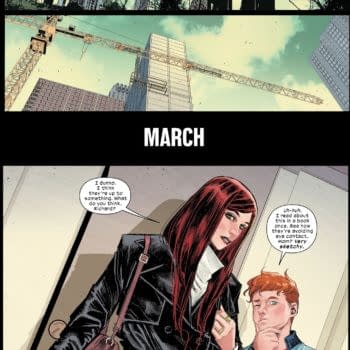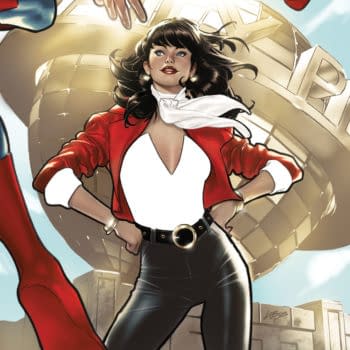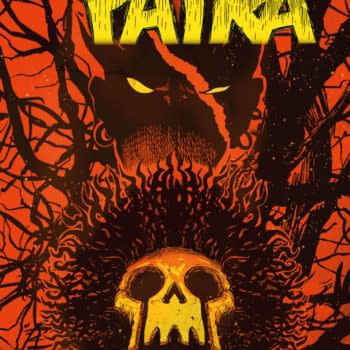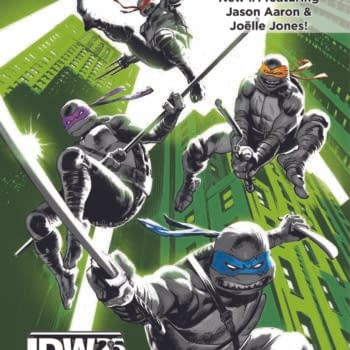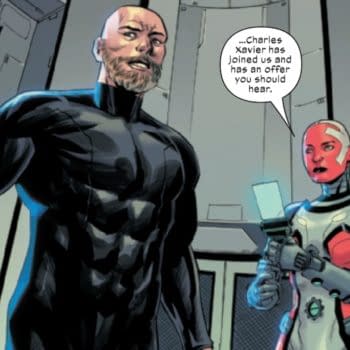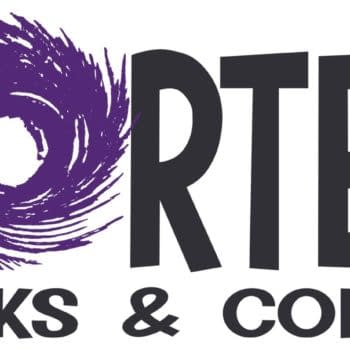Posted in: Comics, san diego comic con | Tagged: 2016, comic con, entertainment, san diego, san diego comic con, sdcc, sdcc2016
Is There Really An Aussie Indie Comics Explosion? San Diego Has The Proof…
This weekend sees San Diego Comic Con hit the ground running – and on Friday 22 July, from 8:00pm in Room 9, there's a panel titled the 'Australian Indie Comics Explosion'.
Featuring visitors Neville Howard, Cristian Roux, W. Chew Chan, Christopher Sequeira, and Darren Koziol, they promise to "explore the renaissance of independent Australian creators using comics as a medium to tell unique and interesting stories." Said panel is intended to provide an overview of their projects and will host a Q&A moderated by Alana Marshall.
Seeing an Australian anything at SDCC is a coup of some standing.
Sometimes it feels like my place of birth is located just beyond the arse end of the world – and straight on 'til morning. It's a far nicer place, of course, than any maligned body cavity or J. M. Barrie ought to indicate.
In fact I love it.
That said I've lived in Tokyo these past fifteen years.
Historically – as an Australian – to be successful at anything you (sadly) usually need to decamp, like Clive James and Barry Humphries heading to London in the swinging '60s, or INXS's big move to America for all of 1983. Even Air Supply and the Bee Gees did a runner, though both groups had strong British roots anyway.
Same thing with Australian actors relocating to Hollywood. It's an opportunity to expand their repertoire, hob–knob with rich and famous celebrities, and thereby actually pay the bills.
The funny thing is once all these Aussies have got a foreign foothold they tended to shine.
Possibly the best–known comics–related example right now would be writer Tom Taylor. He's originally from Melbourne, and in just the past few years has flexed scripting muscles writing the adventures of Iron Man, Batman, Superman, and the all–new Wolverine.
Perth–born artist Ben Templesmith is renowned for his work on the Image Comics series Fell with writer Warren Ellis and IDW's 30 Days of Night with writer Steve Niles. He also joined Niles on Criminal Macabre for Dark Horse.
Artist Nicola Scott (from Sydney) has worked with respected American writers Greg Rucka and Gail Simone on titles like Wonder Woman, Star Wars, Teen Titans, and Superman.
Fil Barlow (Adelaide), with partner Helen Maier, just published the (re)beginning of his Zooniverse in Image Comics' respected anthology Island.
"Brandon Graham," the duo reports, "read Zooniverse in Seattle when he was ten years old, and it inspired him to become a cartoonist – so he contacted us and invited us to submit work for Image."
Meanwhile Chris Wahl (Sydney) has been busy doing variant covers for Titan, as well as being published by Britain's new enfants terrible Dirty Rotten Comics.
Now add Sutu (a.k.a. Stuart Campbell) to the list. He was recently nominated for an Eisner Award for These Memories Won't Last, and is pioneering Augmented Reality comic book storytelling.
So, there's no arguing their success abroad. But what's wrong with the system back home in Oz?
Well, it's not exactly broken – because it never truly existed.
We have no DC or Marvel or IDW.
There is nary an organization – not like Diamond in the 'States – to grant Australian–made comic books national distribution.
The publishers have to resort to their own legwork, often in a literal sense, across a nation about the same size as the continental U.S.A. Which means a helluva lot of exercise, often for returns that barely cover a print–run.
Yet, while traditional fare like The Phantom and MAD (American imports published in Australia) as well as DC and Marvel titles fill out newsagency shelves, locally–produced comic bookage remain fringe–dwellers treated in many respects like a printed version of Hansen's Disease.
Newsagents, supermarkets, convenience stores, and ninety–nine percent of bookshops refuse to touch them.
So how do these people trade their wares?
Specialist comic book stores are the typical option, though wall–space for Australian comics in Australian shops tends to be disproportionately low. Too often the "Local Comics" section is tucked in a gloomy corner, away from the glamour and allure of international imports.
Another avenue is via comic conventions in the major cities, or smaller regional ones such as Sugar City Con in Mackay, Queensland, and Bendigo Record, Comic and Toy Fair in Victoria.
On average, however, indie comic book sales are decreasing across the board at both these outlets, a situation hardly helped by a national media blackout (or at the very least unconsciousness) with which comic books are dealt in Australia.
When Captain America says "Hail Hydra" it makes headlines in Melbourne and Sydney – yet hardly an annual two–inch paragraph is spared for our homegrown equivalent.
One reason why an article like this is running on Bleeding Cool, instead of being embraced by Australian media.
"The local industry is made up of enthusiastic individuals who have to invest their own time, money and energies in creating something from nothing," say the comic creation duo SCAR, a.k.a. Steve Carter and Antoinette Rydyr.
To counter this lack of attention, comic book makers have started to look outside the traditional route and pursue alternative options.
One of the members of the upcoming SDCC panel is Cristian Roux.
He's a respected Melbourne–based artist/writer and creator of comics (Falling Star is heady stuff), as well as self–publisher of same.
Roux assesses that, "With the advent of more small press focused events – like Homecooked Comics Festival, Festival of the Photocopier, Australian Comics Arts Festival, Comic Gong, and the Other Worlds Zine Fair – there is a growing interest and realisation of the possibilities of the medium."
There are now also people who take their comics to a stall at local weekend flea markets.
Subversively still using the traditional route – he's the only comic book publisher currently getting national distribution – is Nat Karmichael, who runs Comicoz in Queensland.
They've been quietly publishing quarterly anthology Oi Oi Oi! for eight issues now, and recently debuted the first nationally distributed Australian superhero (Magpie) in twenty–five years. Comicoz has additionally published coffee–table tomes on past Australian masters like Monty Wedd (Ned Kelly) and John Dixon (Air Hawk).
Karmichael is one of those lucky few people who can talk about love of his country without coming across jingoistic.
"Australia is a beautiful country," he enthuses. "It is unique. There are so many stories that have been and are still to be told in the comic form. Comics are historical artifacts that reflect our culture, both now and in the past. Yet they are, for some odd reason, a forgotten entertainment medium. I publish comic books because those who tell these tales need to have a medium through which they can share with other Australians. And tales already told by creators from our past need to be shared anew – to discover a fresh audience."
More problematic for Australian creators is that this audience is difficult to find. With a population 7.14% of the United States, local sales are a struggle in any industry. Add to that a social stigma or two concerning this particular medium, and it's a tougher sell.
Fil Barlow presents a theory: "Since the '80s, Australian cartoonists have been trying to emulate the American 'superhero' market and success – it's disappointing at seeing that trend continue. Helen and I have invented new comic themes, stuff you won't see anywhere else in the world. We will always offer stories and ideas that can only be found through us, wherever we might be. We're offering it to Australia because our comic work was made here – but it's up to the [Australian] public to embrace it."
Which begs the question Karmichael asks – "Is there an Aussie comics renaissance right now?" – although it's a rhetorical query.
"I want to think so," he continues. "In terms of the quantity of comic titles being published, certainly; in terms of the quantity of comics getting into the hands of the average Australian… I'm not so sure. I think we need to continue to agitate to show that comics are not simply for kids – a perception, sadly, that still exists. I also find it discouraging that major Australian media outlets are presently seeking to increase circulation by including readership offers of Marvel Comics, as opposed to seeking to find local creators to tell Australian stories."
Add to this the old conundrum coined by historian Geoffrey Blainey: tyranny of distance.
The dismal cost of international mail curtails likelihood of hard–copy sales abroad, although Kickstarter campaigns have begun to work around this hurdle by including postage and delivery charges in their costing calculations.
Still, there is room for positive change – and that renaissance Karmichael previously alluded to.
"There certainly do seem to be a lot more people making indie Aussie comics at the moment. And like with everything – from TV to film, games, comics, et cetera – the quality is improving all the time, which then pushes everyone to keep raising the bar." So says Adelaide's Darren Koziol – also on the bill at SDCC. Koziol is not only a writer, editor and publisher, but the man behind Dark Oz – created to publish Australian comic books, mostly anthologies that showcase the work of hundreds of local creators.
Australian artist Graeme Jackson agrees.
"It certainly feels as though Australian comics are going through a bit of a renaissance," he says. "A large number of truly talented individuals have, for some reason, decided to pursue comics, and I couldn't be happier."
"There are some brilliant artists currently rising up in Australia," confirm Carter and Rydyr. "And the comic meetings where creatives gather and meet each month has been inspirational."
Still, writer/artist Matt Kyme moves cautiously counter to any build-up. "I'm not sure if renaissance is the word for it," he reflects. "There are a number of people and companies diligently working towards such a thing – some amazing works are being produced in Australia, both independent and for the majors; incredibly talented individuals and teams working on great stuff. Perhaps we are approaching a renaissance. Still, I'd simply love to see the 'scene' develop into an industry, with infrastructure, to match what other countries already have."
"Renaissance may be too strong a word," agrees Tim McEwen, who juggles positions as a comics creator, comics event organizer (he co-founded the major Supanova pop culture expo), and comics advocate. "It's a tag that can possibly be attributed in hindsight, when we have a few more years' perspective on things. That being said, this is the most incredible time in Australian comics I've witnessed in well over thirty years of involvement."
"I suppose worldwide interest in comics exploded after the saturation of comic–related films released over the last ten years," appraises Stuart Campbell. He makes comics as Sutu, and was just nominated, remember, for that Eisner Award.
"At the same time you've got Tom Taylor writing America's biggest comics, and artists such as Nicola Scott and Tristan Jones drawing them. All of these accomplishments help to galvanise a solid international reputation for Australian artists, and locally it's inspired a generation of upcoming creators."
Says Roux: "There is just an incredible amount of talent, and a number of comic creator groups around Australia that provide support, know–how and encouragement to people making comics. Many of the groups have been around for a number of years, and these informal gatherings allow for an amazing exchange of ideas, experiences, and expertise from older creators to newer ones."
"I respect anyone from Australia sticking to their dream of making comics," injects Skye Ogden, the art director for Perth's ground–breaking Gestalt Comics, as well as a freelance illustrator, "because I know just how hard it is."
Advances in technology and social media have clearly helped create any bubbling new dawn, as Karmichael explains.
"Publishing comics is cheaper now than at any time in our history. Computers, digital printing, and print–on–demand presses have all made the process a lot cheaper."
Adds Campbell: "Also, the advent of Facebook and other social platforms has enabled many artists to share their work and be noticed and for the local community to pull together and support each other. Through these platforms we've seen the organisation and rise of many comic related events, local anthologies and collaborations."
Writer Mark Hobby too points online. "A renaissance? Not sure, but something certainly is going on. I think the Internet has played its part, where creators are more readily able to connect with other creators and audiences, and build a community of like–minded people. Most of the ones who work on comics with me come from overseas – this would not have been possible before the 'Net."
Artist/writer Dan Watts comments, "I see many very talented writers and artists putting in a lot of hard work to produce their comics – and investing in themselves to get the work out there."
"Even the popularity of comic–based films has helped," throws in Sydney artist Chris Wahl.
Jason Franks, a comics writer and novelist based in Melbourne, singles out peer–group support as key to the current upward trend. "I remember the monthly comic meetups in 2007 would have ten people in attendance, maximum. Now we get sixty–plus, without even trying."
"There is a mash of reasons, forming a perfect storm," says McEwen. "The more serious consideration given to comics by creators, storytellers, publishers, the arts community and the public, growing since the 1980s; the increasing ease of dissemination both through limited–run printing and the web. This is all part of a momentum that's been building off–and–on since the mid '80s, and we're continuing to see its benefits. When you add all this up in a geographically remote place like Australia, where we want to make our own work our own way, it not only makes for exciting, great comics – but uniquely Australian ones as well."
So how is this Aussie-made product any different from that we've already been exposed to via the U.S. and Europe?
"Australians have always had a great love of American, English and French comics," appraises Frantz Kantor, a veteran illustrator, animator, and the artist on Magpie. "Our distance helped us keep a lid on copying, so we naturally developed strong individual styles ourselves – not too closely influenced by overseas stuff."
If there's one individual most contemporary Australian creators cite as an influence, it's Gary Chaloner.
With fellow luminaries Dave de Vries, Glenn Lumsden and Tad Pietrzykowski he set up Cyclone Comics in the 1980s, while Kantor was busy doing some of the wildest covers for Inkspot and MAD Magazine.
"In a nutshell? It's taken local comics over thirty years to be an overnight success," Chaloner quips. "Back in the late '70s, it really was the low point for anyone wanting to get into the field in this country.
"Comics in general slowly began to move out of the shadows as the 'Bastard Art' – neither a prose novel, nor a series of paintings or illustrations, but a mongrel combination of the two. They became more acceptable as a form of literature that has an intrinsic value in and of itself. An art form that takes quite a bit to master, but can be appreciated by anyone and everyone. Locally, we have a few amazing comics and graphic novel publishers that are producing world standard, award–winning material that any publisher anywhere in the world would be proud to publish. A comics renaissance? You bet'cha! And it only took 30–odd years."
So yes, Virginia, there is hope Down Under – with a caveat.
"I truly hope," posits Jackson, "that this renewed passion in the local scene manages to grip the general [Australian] public. No matter your preference in terms of story, you will find its equivalent in comics. Sci–fi, fantasy, noir – comics do it all."
Here Roux, one of the reps at the SDCC this Friday, chirps up with a laugh, "Finally," he declares, "there's only one thing better than reading comics… and that's making them!"
A-bloody-men.
Originally from Melbourne, Andrez Bergen writes and occasionally illustrates comic books like Bullet Gal, Tobacco-Stained Mountain Goat, Tales to Admonosh, and Trista & Holt.















